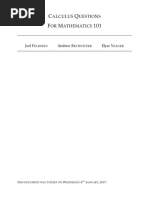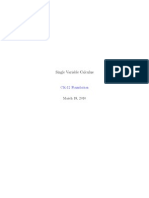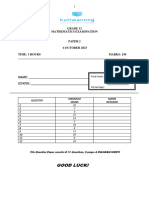0 ratings0% found this document useful (0 votes)
22 viewsCourse Notes On Calculus 2
Uploaded by
wociron113Copyright
© © All Rights Reserved
Available Formats
Download as DOCX, PDF, TXT or read online on Scribd
0 ratings0% found this document useful (0 votes)
22 viewsCourse Notes On Calculus 2
Uploaded by
wociron113Copyright
© © All Rights Reserved
Available Formats
Download as DOCX, PDF, TXT or read online on Scribd
You are on page 1/ 5
Course Notes on Calculus 2
Calculus 2, often considered a continuation of the introductory Calculus 1
course, dives deeper into more advanced techniques of differentiation and
integration, introducing topics such as integration techniques, sequences
and series, parametric equations, polar coordinates, and more. This course
plays a crucial role in understanding the behavior of functions, their areas,
and the physical principles they may represent. Below, we will explore some
of the key concepts and methods covered in a typical Calculus 2 course.
1. Integration Techniques
Integration is the fundamental tool used to find areas, volumes, and solve
problems in physics and engineering. Building on the basic techniques
learned in Calculus 1, Calculus 2 introduces several advanced methods for
evaluating integrals. These include:
a. Integration by Substitution
This method, often seen as the reverse of the chain rule in differentiation, is
used when an integral contains a composite function. The idea is to simplify
the integral by making a substitution, effectively transforming the integral
into a simpler form. For example, if we have an integral like:
∫f(g(x))g′(x) dx,\int f(g(x))g'(x) \, dx,∫f(g(x))g′(x)dx,
we can make the substitution u=g(x)u = g(x)u=g(x), and du=g′(x) dxdu =
g'(x) \, dxdu=g′(x)dx, converting the integral into:
∫f(u) du.\int f(u) \, du.∫f(u)du.
b. Integration by Parts
The integration by parts formula is derived from the product rule for
differentiation and is particularly useful for integrals involving the product of
two functions. The formula is:
∫u dv=uv−∫v du.\int u \, dv = uv - \int v \, du.∫udv=uv−∫vdu.
Choosing uuu and dvdvdv effectively can often simplify an otherwise difficult
integral. This method is commonly used for integrals involving logarithmic,
trigonometric, or exponential functions.
c. Trigonometric Integrals
Integrals involving trigonometric functions can often be simplified using
trigonometric identities. For example, integrals like:
∫sin2(x) dx\int \sin^2(x) \, dx∫sin2(x)dx
can be simplified by using the identity sin2(x)=1−cos(2x)2\sin^2(x) = \
frac{1 - \cos(2x)}{2}sin2(x)=21−cos(2x). Other standard techniques involve
using substitution or parts when needed.
d. Partial Fraction Decomposition
This technique is used for rational functions, where the integrand is a ratio of
two polynomials. The idea is to express the rational function as a sum of
simpler fractions, which can then be integrated individually. The method
works by factoring the denominator and then finding constants that allow the
original fraction to be rewritten as a sum of simpler terms.
e. Trigonometric Substitution
When integrals involve square roots of expressions like a2−x2a^2 -
x^2a2−x2, a2+x2a^2 + x^2a2+x2, or x2−a2x^2 - a^2x2−a2,
trigonometric substitution is a helpful technique. It involves substituting a
trigonometric function for the variable, making the integral easier to handle.
For example, for a2−x2\sqrt{a^2 - x^2}a2−x2, we substitute x=asin(θ)x =
a \sin(\theta)x=asin(θ).
2. Applications of Integration
In addition to finding areas and volumes, integrals are used in various
applied fields. Calculus 2 introduces several important applications of
integration:
a. Area Between Curves
To find the area between two curves, y=f(x)y = f(x)y=f(x) and y=g(x)y =
g(x)y=g(x), over the interval [a,b][a, b][a,b], we subtract the integral of the
lower curve from the integral of the upper curve:
Area=∫ab[f(x)−g(x)] dx.\text{Area} = \int_a^b [f(x) - g(x)] \, dx.Area=∫ab
[f(x)−g(x)]dx.
b. Volume of Solids of Revolution
The volume of a solid formed by rotating a region around an axis can be
computed using integration. There are two main methods for doing this: the
disk method and the shell method. The disk method uses the formula:
V=π∫ab[f(x)]2 dx,V = \pi \int_a^b [f(x)]^2 \, dx,V=π∫ab[f(x)]2dx,
while the shell method involves using cylindrical shells:
V=2π∫abxf(x) dx.V = 2\pi \int_a^b x f(x) \, dx.V=2π∫abxf(x)dx.
c. Arc Length
The length of a curve between two points x=ax = ax=a and x=bx = bx=b is
given by:
L=∫ab1+(f′(x))2 dx.L = \int_a^b \sqrt{1 + (f'(x))^2} \, dx.L=∫ab1+(f′(x))2dx.
This formula is derived from the Pythagorean theorem and is used to
compute the length of curves in applications such as physics, engineering,
and computer graphics.
d. Surface Area
The surface area of a solid generated by rotating a curve y=f(x)y =
f(x)y=f(x) around the x-axis is calculated using the formula:
SA=2π∫abf(x)1+(f′(x))2 dx.SA = 2\pi \int_a^b f(x) \sqrt{1 + (f'(x))^2} \,
dx.SA=2π∫abf(x)1+(f′(x))2dx.
This formula can also be applied to curves rotated around the y-axis or other
axes, depending on the problem.
3. Sequences and Series
In Calculus 2, sequences and series play a major role in understanding the
behavior of functions and approximating complicated expressions.
a. Sequences
A sequence is an ordered list of numbers, where each term is determined by
a rule or formula. Sequences are important for understanding limits, as many
sequences approach a particular value as the number of terms increases. A
key concept here is the limit of a sequence, where we analyze the behavior
of the sequence as the number of terms tends to infinity. For example, the
sequence an=1na_n = \frac{1}{n}an=n1 approaches 0 as n→∞n \to \
inftyn→∞.
b. Series
A series is the sum of the terms of a sequence. A simple example is the
infinite geometric series:
S=a+ar+ar2+ar3+… .S = a + ar + ar^2 + ar^3 + \dots.S=a+ar+ar2+ar3+
….
The sum of an infinite series is only meaningful if it converges, meaning that
the sum approaches a finite value as more terms are added. A key result in
series is the geometric series test:
S=a1−rfor∣r∣<1.S = \frac{a}{1 - r} \quad \text{for} \quad |r| < 1.S=1−ra
for∣r∣<1.
c. Convergence Tests
Determining whether a series converges or diverges is a central topic in
Calculus 2. Several tests help determine this, including the ratio test, the
root test, the integral test, and the comparison test. Each of these provides a
method for analyzing series to see if their sums approach a finite number or
not. For instance, the ratio test involves computing the limit:
L=limn→∞∣an+1an∣.L = \lim_{n \to \infty} \left| \frac{a_{n+1}}{a_n} \
right|.L=n→∞limanan+1.
If L<1L < 1L<1, the series converges; if L>1L > 1L>1, it diverges; if L=1L =
1L=1, the test is inconclusive.
d. Power Series
Power series are infinite sums of the form:
∑n=0∞an(x−c)n.\sum_{n=0}^{\infty} a_n (x - c)^n.n=0∑∞an(x−c)n.
These series are useful for approximating functions, and if the series
converges for a certain range of xxx, it can be used to approximate the
function within that interval. A common example of a power series is the
Taylor series, which approximates a function near a point by using the
function's derivatives at that point.
4. Parametric Equations and Polar Coordinates
In addition to working with functions expressed in the form y=f(x)y =
f(x)y=f(x), Calculus 2 also explores parametric equations and polar
coordinates, which provide alternative ways to describe curves.
a. Parametric Equations
Parametric equations express the coordinates of points on a curve as
functions of a parameter, usually ttt. For example, the parametric equations
for a circle of radius rrr centered at the origin are:
x=rcos(t),y=rsin(t).x = r \cos(t), \quad y = r \sin(t).x=rcos(t),y=rsin(t).
Parametric equations allow for the representation of curves that cannot be
expressed as functions in the usual sense, such as loops or curves with
vertical tangents. The derivative of parametric curves is found using:
dydx=dydtdxdt.\frac{dy}{dx} = \frac{\frac{dy}{dt}}{\frac{dx}{dt}}.dxdy
=dtdxdtdy.
b. Polar Coordinates
Polar coordinates describe points in the plane using a radius rrr and an angle
θ\thetaθ, rather than Cartesian coordinates (x,y)(x, y)(x,y). The relationship
between polar and Cartesian coordinates is given by:
x=rcos(θ),y=rsin(θ).x = r \cos(\theta), \quad y = r \sin(\
theta).x=rcos(θ),y=rsin(θ).
Polar coordinates are particularly useful in problems involving symmetry,
such as calculating the area enclosed by curves in circular or spiral shapes.
The area of a region in polar coordinates is given by the formula:
A=12∫θ1θ2r2 dθ.A = \frac{1}{2} \int_{\theta_1}^{\theta_2} r^2 \, d\
theta.A=21∫θ1θ2r2dθ.
5. Conclusion
Calculus 2 builds upon the foundational concepts learned in Calculus 1 and
provides powerful tools for solving a wide variety of mathematical, scientific,
and engineering problems. The techniques of integration by substitution,
integration by parts, trigonometric integrals, and partial fraction
decomposition allow for the evaluation of more complex integrals. In
addition, applications of integration, sequences and series, and parametric
equations help to extend the utility of calculus in various
You might also like
- Calculus For Scientists and Engineers II: Math 20B at UCSD: William Stein March 15, 2006No ratings yetCalculus For Scientists and Engineers II: Math 20B at UCSD: William Stein March 15, 200686 pages
- Calculus II: Veselin Jungic & Jamie Mulholland Department of Mathematics Simon Fraser UniversityNo ratings yetCalculus II: Veselin Jungic & Jamie Mulholland Department of Mathematics Simon Fraser University209 pages
- Calculus Volume 2 Second University of Manitoba Edition 1696990394No ratings yetCalculus Volume 2 Second University of Manitoba Edition 1696990394471 pages
- Solutions Manual to accompany Calculus with Analytic Geometry 7th edition 9780618141807pdf download100% (6)Solutions Manual to accompany Calculus with Analytic Geometry 7th edition 9780618141807pdf download39 pages
- Name:Animesh Sahoo Roll No: 03 ADMISIION NO:20063373 Class:Xii-ANo ratings yetName:Animesh Sahoo Roll No: 03 ADMISIION NO:20063373 Class:Xii-A7 pages
- Applications of Integration in CalculusNo ratings yetApplications of Integration in Calculus13 pages
- MATH-101 - Calculus Analytical Geometry (OBE) Fall 2018No ratings yetMATH-101 - Calculus Analytical Geometry (OBE) Fall 20184 pages
- Free Access to Solutions Manual to accompany Calculus with Analytic Geometry 7th edition 9780618141807 Chapter Answers100% (8)Free Access to Solutions Manual to accompany Calculus with Analytic Geometry 7th edition 9780618141807 Chapter Answers39 pages
- Calculus Concepts and Contexts 4th Edition Stewart Solutions Manual instant download100% (1)Calculus Concepts and Contexts 4th Edition Stewart Solutions Manual instant download54 pages
- Instant download Calculus Concepts and Contexts 4th Edition Stewart Solutions Manual pdf all chapter100% (17)Instant download Calculus Concepts and Contexts 4th Edition Stewart Solutions Manual pdf all chapter52 pages
- Calculus Concepts and Contexts 4th Edition Stewart Solutions Manualinstant download100% (3)Calculus Concepts and Contexts 4th Edition Stewart Solutions Manualinstant download36 pages
- CK 12 Texas Instruments Calculus Student Edition: OundationNo ratings yetCK 12 Texas Instruments Calculus Student Edition: Oundation62 pages
- Single Variable Calculus Concepts and Contexts 4th Edition Stewart Solutions Manualpdf download100% (1)Single Variable Calculus Concepts and Contexts 4th Edition Stewart Solutions Manualpdf download52 pages
- Instant Access to Concepts in Calculus II Beta Version Miklós Bóna ebook Full Chapters100% (8)Instant Access to Concepts in Calculus II Beta Version Miklós Bóna ebook Full Chapters75 pages
- Richard Bagby..Introductory Analysis.a Deeper View of CalculusNo ratings yetRichard Bagby..Introductory Analysis.a Deeper View of Calculus219 pages
- Lecture Notes: Integral Calculus and Differential EquationsNo ratings yetLecture Notes: Integral Calculus and Differential Equations137 pages
- [Ebooks PDF] download Calculus and Analysis A Combined Approach 1st Edition Horst R. Beyer full chapters100% (2)[Ebooks PDF] download Calculus and Analysis A Combined Approach 1st Edition Horst R. Beyer full chapters80 pages
- A Deeper View of Calculus by Richard J Bagby100% (1)A Deeper View of Calculus by Richard J Bagby219 pages
- PDF Calculus and Analysis A Combined Approach 1st Edition Horst R. Beyer download100% (7)PDF Calculus and Analysis A Combined Approach 1st Edition Horst R. Beyer download81 pages
- MATH-101 - Calculus Analytical Geometry (OBE) Fall 2018No ratings yetMATH-101 - Calculus Analytical Geometry (OBE) Fall 20185 pages
- Solutions Manual to accompany Calculus with Analytic Geometry 7th edition 9780618141807 instant download100% (2)Solutions Manual to accompany Calculus with Analytic Geometry 7th edition 9780618141807 instant download38 pages
- J. R. Kantor - Psychology and Logic - Vol. II. 2-Principia Press (1950)No ratings yetJ. R. Kantor - Psychology and Logic - Vol. II. 2-Principia Press (1950)372 pages
- Module-94C: Importance of Surveying, Principles and Classification, Mapping Concepts, Coordinate System, Map ProjectionsNo ratings yetModule-94C: Importance of Surveying, Principles and Classification, Mapping Concepts, Coordinate System, Map Projections37 pages
- Measure of Angles Created by A TransversalNo ratings yetMeasure of Angles Created by A Transversal20 pages
- Promaths Grade 12 Maths Paper 2 (6 Oct 2023)100% (1)Promaths Grade 12 Maths Paper 2 (6 Oct 2023)16 pages
- Straight Lines Enhancement Assignment 2 1665546133021No ratings yetStraight Lines Enhancement Assignment 2 16655461330216 pages
- Lesson 1.5: Measurements of Directions and Angles: Unit INo ratings yetLesson 1.5: Measurements of Directions and Angles: Unit I12 pages
- Sadhu Vaswani International School: I. Choose The Correct AnswersNo ratings yetSadhu Vaswani International School: I. Choose The Correct Answers2 pages
- Maths Class X Sample Paper Test 02 For Board Exam 2024 AnswersNo ratings yetMaths Class X Sample Paper Test 02 For Board Exam 2024 Answers13 pages
- SYLLABUS Teaching Math in The Primary SPEC 108 BEED 2 2023 2024No ratings yetSYLLABUS Teaching Math in The Primary SPEC 108 BEED 2 2023 20248 pages
- Mathematics T Trial P2 STPM 2014 SABS Kuantan Mark SchemeNo ratings yetMathematics T Trial P2 STPM 2014 SABS Kuantan Mark Scheme9 pages
- Clase Práctica Funciones y Modelos CuadráticosNo ratings yetClase Práctica Funciones y Modelos Cuadráticos17 pages
- Exercise 10.3 (Solutions) : Question # 1No ratings yetExercise 10.3 (Solutions) : Question # 17 pages
- Calculus For Scientists and Engineers II: Math 20B at UCSD: William Stein March 15, 2006Calculus For Scientists and Engineers II: Math 20B at UCSD: William Stein March 15, 2006
- Calculus II: Veselin Jungic & Jamie Mulholland Department of Mathematics Simon Fraser UniversityCalculus II: Veselin Jungic & Jamie Mulholland Department of Mathematics Simon Fraser University
- Calculus Volume 2 Second University of Manitoba Edition 1696990394Calculus Volume 2 Second University of Manitoba Edition 1696990394
- A-level Maths Revision: Cheeky Revision ShortcutsFrom EverandA-level Maths Revision: Cheeky Revision Shortcuts
- Solutions Manual to accompany Calculus with Analytic Geometry 7th edition 9780618141807pdf downloadSolutions Manual to accompany Calculus with Analytic Geometry 7th edition 9780618141807pdf download
- Name:Animesh Sahoo Roll No: 03 ADMISIION NO:20063373 Class:Xii-AName:Animesh Sahoo Roll No: 03 ADMISIION NO:20063373 Class:Xii-A
- MATH-101 - Calculus Analytical Geometry (OBE) Fall 2018MATH-101 - Calculus Analytical Geometry (OBE) Fall 2018
- Free Access to Solutions Manual to accompany Calculus with Analytic Geometry 7th edition 9780618141807 Chapter AnswersFree Access to Solutions Manual to accompany Calculus with Analytic Geometry 7th edition 9780618141807 Chapter Answers
- Calculus Concepts and Contexts 4th Edition Stewart Solutions Manual instant downloadCalculus Concepts and Contexts 4th Edition Stewart Solutions Manual instant download
- Instant download Calculus Concepts and Contexts 4th Edition Stewart Solutions Manual pdf all chapterInstant download Calculus Concepts and Contexts 4th Edition Stewart Solutions Manual pdf all chapter
- Calculus Concepts and Contexts 4th Edition Stewart Solutions Manualinstant downloadCalculus Concepts and Contexts 4th Edition Stewart Solutions Manualinstant download
- CK 12 Texas Instruments Calculus Student Edition: OundationCK 12 Texas Instruments Calculus Student Edition: Oundation
- Single Variable Calculus Concepts and Contexts 4th Edition Stewart Solutions Manualpdf downloadSingle Variable Calculus Concepts and Contexts 4th Edition Stewart Solutions Manualpdf download
- Instant Access to Concepts in Calculus II Beta Version Miklós Bóna ebook Full ChaptersInstant Access to Concepts in Calculus II Beta Version Miklós Bóna ebook Full Chapters
- Richard Bagby..Introductory Analysis.a Deeper View of CalculusRichard Bagby..Introductory Analysis.a Deeper View of Calculus
- Lecture Notes: Integral Calculus and Differential EquationsLecture Notes: Integral Calculus and Differential Equations
- [Ebooks PDF] download Calculus and Analysis A Combined Approach 1st Edition Horst R. Beyer full chapters[Ebooks PDF] download Calculus and Analysis A Combined Approach 1st Edition Horst R. Beyer full chapters
- PDF Calculus and Analysis A Combined Approach 1st Edition Horst R. Beyer downloadPDF Calculus and Analysis A Combined Approach 1st Edition Horst R. Beyer download
- MATH-101 - Calculus Analytical Geometry (OBE) Fall 2018MATH-101 - Calculus Analytical Geometry (OBE) Fall 2018
- Solutions Manual to accompany Calculus with Analytic Geometry 7th edition 9780618141807 instant downloadSolutions Manual to accompany Calculus with Analytic Geometry 7th edition 9780618141807 instant download
- J. R. Kantor - Psychology and Logic - Vol. II. 2-Principia Press (1950)J. R. Kantor - Psychology and Logic - Vol. II. 2-Principia Press (1950)
- Module-94C: Importance of Surveying, Principles and Classification, Mapping Concepts, Coordinate System, Map ProjectionsModule-94C: Importance of Surveying, Principles and Classification, Mapping Concepts, Coordinate System, Map Projections
- Straight Lines Enhancement Assignment 2 1665546133021Straight Lines Enhancement Assignment 2 1665546133021
- Lesson 1.5: Measurements of Directions and Angles: Unit ILesson 1.5: Measurements of Directions and Angles: Unit I
- Sadhu Vaswani International School: I. Choose The Correct AnswersSadhu Vaswani International School: I. Choose The Correct Answers
- Maths Class X Sample Paper Test 02 For Board Exam 2024 AnswersMaths Class X Sample Paper Test 02 For Board Exam 2024 Answers
- SYLLABUS Teaching Math in The Primary SPEC 108 BEED 2 2023 2024SYLLABUS Teaching Math in The Primary SPEC 108 BEED 2 2023 2024
- Mathematics T Trial P2 STPM 2014 SABS Kuantan Mark SchemeMathematics T Trial P2 STPM 2014 SABS Kuantan Mark Scheme

























































































